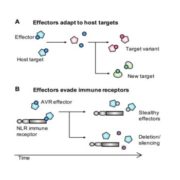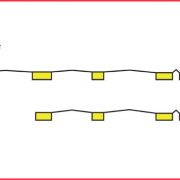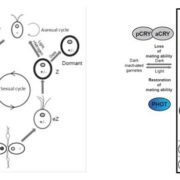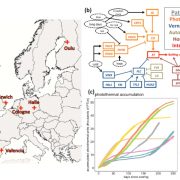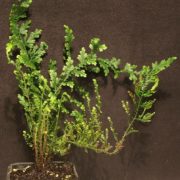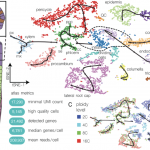Origins and evolution of cuticle biosynthetic machinery in land plants (Plant Physiology)
 The availability of annotated genomes for a wide range of plants allows for tremendous opportunity to perform comparative genomics studies such as that carried out by Kong et al. detailing the evolution of cuticle biosynthesis. The cuticle is the waxy hydrophobic layer that protects aerial plant tissue from dehydration and environmental stresses. Its synthesis involves several components, hypothesized to have evolved as a means for plants to adapt to land colonization. The authors identified the genomic components of cuticle biosynthesis within 41 different plant species covering the major lineages, from algal species to several angiosperms including the model organism Arabidopsis thaliana. While algal species only contain partial sets of cuticle biosynthesis genes, bryophytes comprise a basic set of cuticle biosynthesis machinery, and spermatophytes, the seed plants, express the most robust set of cuticle biosynthesis genes. This genomics work was coupled with chemical composition and phenotype analysis of cuticles from 13 representative plant species. Notably, cutin and wax loads in cuticles of seed plants were significantly higher in mass proportion measurements than in those of monilophytes, lycophytes, and bryophytes, with bryophytes having the lowest proportions of all. Biochemical composition of cuticular components from bryophytic to spermatophytic species changed as well. Further, spermatophyte cuticles demonstrated greater hydrophobicity and moisture retention ability than other plant species. This study confirms that components of cuticle biosynthesis machinery first evolved in algal species, but “canonical” cuticles originated in the first land plant ancestors and developed into a key adaptation for terrestrial colonization. (Summary by Benjamin Jin) Plant Physiology 10.1104/pp.20.00913
The availability of annotated genomes for a wide range of plants allows for tremendous opportunity to perform comparative genomics studies such as that carried out by Kong et al. detailing the evolution of cuticle biosynthesis. The cuticle is the waxy hydrophobic layer that protects aerial plant tissue from dehydration and environmental stresses. Its synthesis involves several components, hypothesized to have evolved as a means for plants to adapt to land colonization. The authors identified the genomic components of cuticle biosynthesis within 41 different plant species covering the major lineages, from algal species to several angiosperms including the model organism Arabidopsis thaliana. While algal species only contain partial sets of cuticle biosynthesis genes, bryophytes comprise a basic set of cuticle biosynthesis machinery, and spermatophytes, the seed plants, express the most robust set of cuticle biosynthesis genes. This genomics work was coupled with chemical composition and phenotype analysis of cuticles from 13 representative plant species. Notably, cutin and wax loads in cuticles of seed plants were significantly higher in mass proportion measurements than in those of monilophytes, lycophytes, and bryophytes, with bryophytes having the lowest proportions of all. Biochemical composition of cuticular components from bryophytic to spermatophytic species changed as well. Further, spermatophyte cuticles demonstrated greater hydrophobicity and moisture retention ability than other plant species. This study confirms that components of cuticle biosynthesis machinery first evolved in algal species, but “canonical” cuticles originated in the first land plant ancestors and developed into a key adaptation for terrestrial colonization. (Summary by Benjamin Jin) Plant Physiology 10.1104/pp.20.00913



